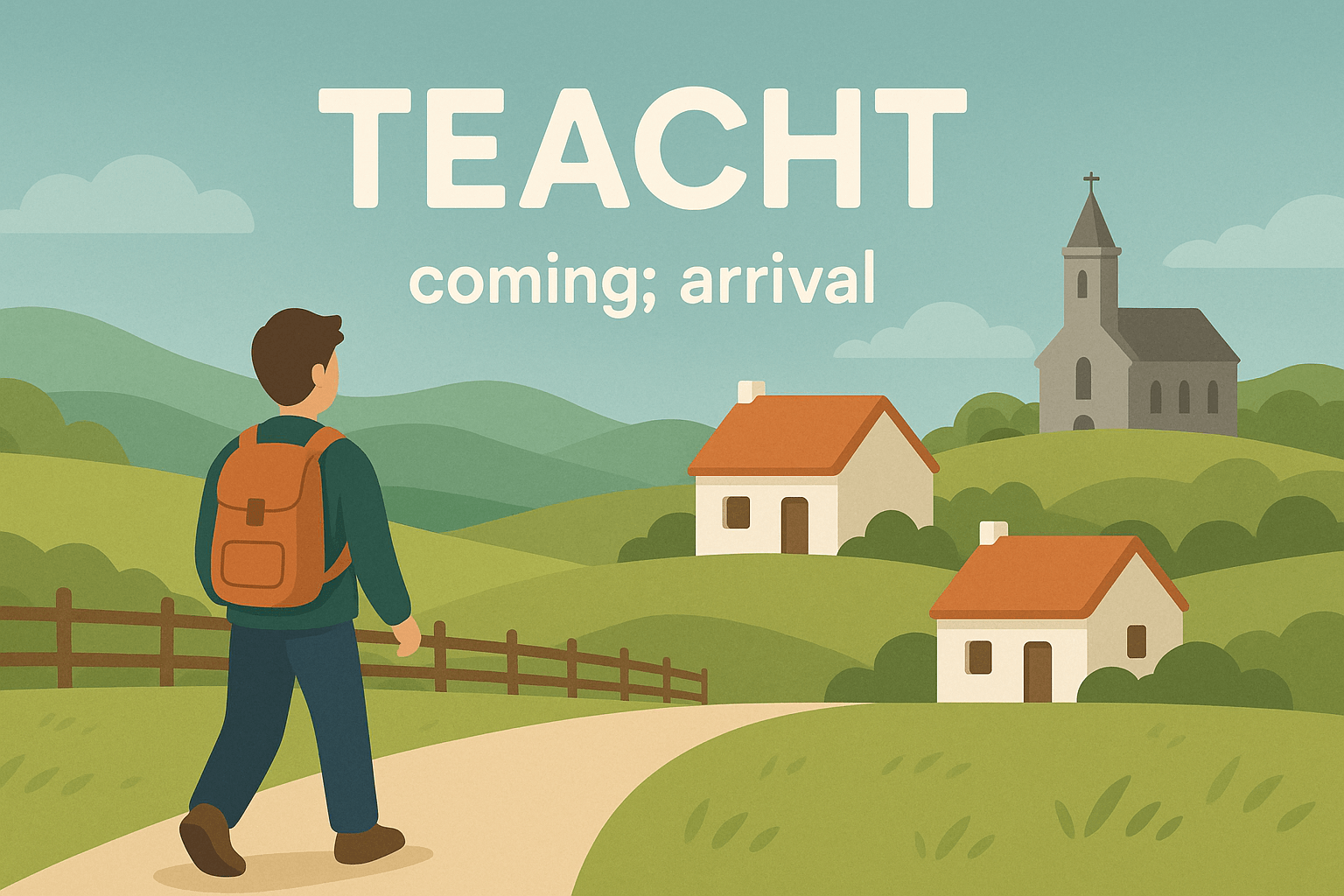The Irish word teacht (pronounced tyahkt) means “coming” or “arrival.”
It’s one of the most common words you’ll come across when learning everyday Irish. You’ll often hear it in phrases like:
- Tá sé ag teacht — He is coming
- Bhí sí ag teacht abhaile — She was coming home
- Roimh theacht an gheimhridh — Before the coming of winter
In other words, teacht is used whenever someone or something is on the way or arriving — a simple but powerful word for learners to master.
Breaking Down the Word “Teacht”
Part of Speech:
- Teacht can act as a noun meaning arrival or coming.
- It’s related to the verb “tar” (to come) — the root of many everyday phrases.
Pronunciation:
- In most dialects, teacht sounds like “tyahkt.”
- The “ea” has a short “a” sound, and the “cht” is that typical Irish throat sound — a soft clearing of the throat.
If you’re unsure how to pronounce it, you can listen to native examples on Teanglann.ie to hear the different regional pronunciations.
How to Use “Teacht” in Simple Sentences
To help you get comfortable, here are a few common examples you can start practising today:
| Irish | English |
|---|---|
| Tá sé ag teacht. | He is coming. |
| Tá siad ag teacht níos déanaí. | They are coming later. |
| Roimh theacht an tsamhraidh. | Before the coming of summer. |
| Tar éis teacht abhaile. | After coming home. |
| Tá fáilte roimh do theacht. | Your arrival is welcome. |
Notice how the word teacht can appear both on its own and as part of phrases with ag (at), roimh (before), or tar éis (after).
Related Words and Phrases
Understanding teacht can help you learn other common Irish expressions around movement and arrival:
- Tháinig — came (past tense of “tar”)
- Tháinig mé go luath. → I came early.
- Tiocfaidh — will come (future tense)
- Tiocfaidh siad amárach. → They will come tomorrow.
- Téigh — go (the opposite direction of “come”)
- Téim go dtí an scoil gach maidin. → I go to school every morning.
If you’re curious about how these motion verbs connect, check out our Irish Pronouns Guide — it’ll help you form sentences correctly as you start to build confidence in Irish grammar.
Common Expressions Using “Teacht”
You’ll see teacht used not just in literal movement, but also in expressions describing events, opportunities, or even emotions. For example:
- Teacht an lae — the coming of the day
- Teacht na Nollag — the coming of Christmas
- Teacht chugam féin — coming to myself (recovering)
It’s a flexible, everyday word that works for physical arrival or figurative change — something arriving, beginning, or happening.
Why “Teacht” Is a Great Word for Beginners
Learning teacht early helps you:
- Understand basic sentence patterns in Irish.
- Recognize motion verbs and how they’re formed.
- Build real, useful phrases that sound natural in conversation.
Irish can feel complex at first, but focusing on small, high-frequency words like teacht gives you quick wins. Every time you say tá mé ag teacht (“I’m coming”), you’re not just learning a word — you’re speaking Irish confidently.
Practice Tips for Learners
Here are a few easy ways to practise using teacht daily:
- Say it aloud — Repeat simple sentences:
“Tá mé ag teacht.” / “Tá sí ag teacht.” / “Tá siad ag teacht.” - Write a short diary entry —
Bhí mo chairde ag teacht go Gaillimh inniu. (“My friends were coming to Galway today.”) - Use Gaeilgeoir AI to test pronunciation and get feedback on your sentence construction.
The platform uses AI to help you practise speaking and listening — sign up for free here.
Grammar Tip: “Ag Teacht” vs “Teacht”
- Ag teacht literally means “at coming” → used for ongoing actions (is coming / are coming).
- Teacht on its own is the noun (“arrival / coming”).
Examples:
- Tá an traein ag teacht. → The train is coming.
- Fan go dtí teacht an traein. → Wait until the arrival of the train.
That small difference shows how flexible Irish can be once you get familiar with word forms!
Similar Words to Explore Next
Once you’ve learned teacht, here are a few related words to help expand your Irish vocabulary:
- Imeacht — going, departure
- Tagairt — reference
- Tús — beginning
- Críoch — end
You can explore more Irish words and their meanings in our Irish Idioms Language Learning Guide — it’s a great next step after learning teacht.
Conclusion: A Small Word with Big Importance
Teacht might seem simple, but it’s one of those essential Irish words that opens the door to everyday fluency.
It’s used in greetings, conversations, storytelling, and even traditional songs — always expressing something that’s on its way or about to begin.
Whether you’re talking about teacht an gheimhridh (the coming of winter) or saying Tá sé ag teacht anois (He’s coming now), you’re connecting directly with how Irish speakers think about time and movement.
So the next time you practise, try saying a few sentences out loud — you’ll feel the rhythm of the language.
And if you’d like to keep building your Irish step-by-step, join our community and start practising with AI-powered Irish tools at Gaeilgeoir AI.


